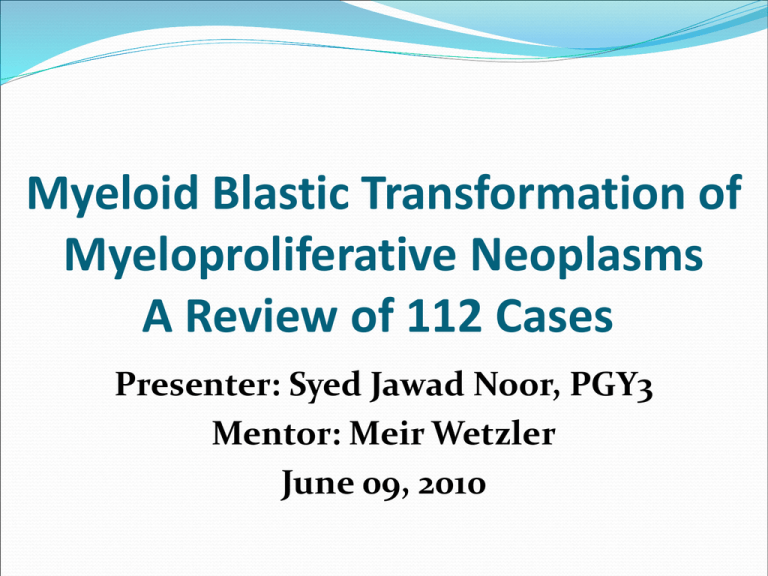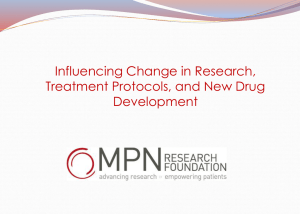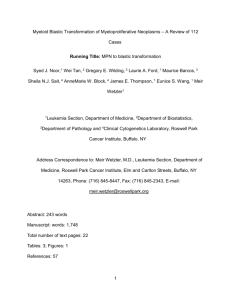Myeloid Blastic Transformation of Myeloproliferative Neoplasms – A
advertisement

Myeloid Blastic Transformation of Myeloproliferative Neoplasms A Review of 112 Cases Presenter: Syed Jawad Noor, PGY3 Mentor: Meir Wetzler June 09, 2010 Our Team Syed J. Noor Wei Tan Gregory E. Wilding Laurie A. Ford Maurice Barcos Sheila N.J. Sait Annemarie W. Block James E. Thompson Eunice S. Wang Meir Wetzler Myeloproliferative Neoplasms (MPNs) • Clonal hematologic diseases • Excess production of ≥1 lineages of mature blood cells • Predisposition to bleeding and thrombotic complications • Extramedullary hemotopoiesis • A variable progression to leukemia MPN Types • Polycythemia Vera (PV) • Essential Thrombocythemia (ET) • Myelofibrosis (MF) Primary MF (PMF) Secondary MF (SMF) Polycythemia Vera (PV) An expansion in red blood cell production Essential Thrombocytosis (ET) An isolated elevation in platelet count Myelofibrosis (MF) • A fibrotic bone marrow and peripheral cytopenia • Higher risk of leukemic transformation Primary or secondary (post-PV or post-ET) JAK2 mutation in MPN L P JAK2 JAK2 P Signaling JAK2 JAK2 Signaling 95% in PV; 50-60% in ET and MF Myeloid Blastic Transformation of Myeloproliferative Neoplasms • MPNs are known to transform into acute leukemia in approximately 4-6% of the patients • ~50% of acute leukemia cases following JAK2positive MPN continue to carry the mutation • Pathogenesis of the blastic transformation in MPN remains unclear Known risk factors for Blastic Transformation • Alkylating agents • Radiation • DNA damaging chemotherapy drugs Research Study Objectives • To gain more insight into the evolution & risk factors playing role in blastic transformation • Treatment outcome of patients developing blastic transformation from classic MPN Methods Patients • 89 cases from literature • 23 cases from RPCI • PV, ET, MF, SMF or MPN-U • Blast phase defined as persistent ≥20% marrow or peripheral blood blasts Contd… • Therapy • anthracycline (daunorubicin at 60 mg/m2) + cytosine arabinoside (100 mg/m2) chemotherapy in a “7+3” fashion Contd… • 3 pt had SCT in addition to chemotherapy • All other pts received supportive care only • Response was CR or CRi Statistical Analyses • Fisher’s exact test. • Wilcoxon rank sum test. • Kaplan-Meier method. • log-rank test. • SAS (version 9.1) Results • Both RPCI and literature pt. populations • • • • • did not differ in Age at diagnosis of MPN or blastic transformation, Gender Prior use of interferon Karyotype aberrations Overall survival of the two cohorts was similar and poor Comparison between RPCI dataset and other three datasets Diagnosis Differences 60 53.3 Percent 50 40 30 20 24.4 26.1 22.2 26.1 21.7 17.4 8.7 10 0 ET PMF PV 0 0 SMF UN Other RPCI Time from MPN diagnosis to Blast phase 80 68.2 70 60 Percent P 0.0173 60.9 50 40 39.1 31.8 30 20 10 0 <5Years ≥ 5 Years Other RPCI Less than 3 Therapies 120 P <0.0001 100 100 84 Percent 80 Other RPCI 60 40 20 16 0 0 Yes No Prior Hydroxyurea Therapy 80 73.2 70 P .0057 63.2 Percent 60 50 36.8 40 30 26.8 20 10 0 Yes No Other RPCI Prior Alkylating Agents 100 94.7 90 P <0.0001 80 Percent 70 60 54.9 45.1 50 40 30 20 5.3 10 0 Yes No Other RPCI Prior Erythropoietin 120 P 0.0339 100 100 89.5 Percent 80 Other RPCI 60 40 20 0 10.5 0 Yes No Normal Karyotype 100 92.7 90 P 0.0033 80 65 Percent 70 60 Other RPCI 50 35 40 30 20 10 7.3 0 Yes No Insignificant Variables of both Cohorts • Age @ MPN diagnosis • Age @ AML diagnosis • Gender • Prior use of Interferon • Karyotype aberrations Overall Survival Survival analysis for RPCI + other three data sets Survival By Diagnosis 35 30 Months 25 20 Median Survival 15 10 5 0 ET PMF PV SMF UN Age at MPN Diagnosis Age @ MPN <60 ≥60 P=0.0493 Less than 3 Therapies <3 Therapies N Y P=0.0242 Complex Karyotype Complex Karyotype N Y P=0.0104 Non-significant variables • Time from MPN diagnosis to Blast phase • Age @ AML diagnosis • Gender • Prior Hydroxyurea • Prior Alkylating Agents • Prior Erythropoietin • Prior Interferon • Karyotype abnormalities other than Complex Kryotype Survival analysis for RPCI dataset 14 P <0.0001 P 0.0009 8 P 0.0119 10 P 0.0031 Median Survival in Months 12 Yes 6 No 4 2 0 Induction Allogenic Supportive care Chemotherapy Transplantation Response Discussion Reasons for the heterogeneity -- Differing criteria for MPN diagnosis --Variety in the yield of karyotype analysis Whether blastic transformation is a sequel of therapy, natural progression or a combination of the two continues Contd…. • Superior survival with allogeneic SCT • SCT should be considered before the disease progresses to the blastic phase Contd…. • Selective JAK1 and JAK2 inhibitor, INCB018424, has demonstrated some single agent activity in relapsed/refractory patients with leukemic transformation of Myelofibrosis Conclusion • Patients with <3 prior therapies & • Lack of complex karyotype have longer survival • Attempts for early identification of patients at risk for disease progression • Allogeneic SCT for the eligible patient • Searching for novel therapeutic agents, alone or in combination











